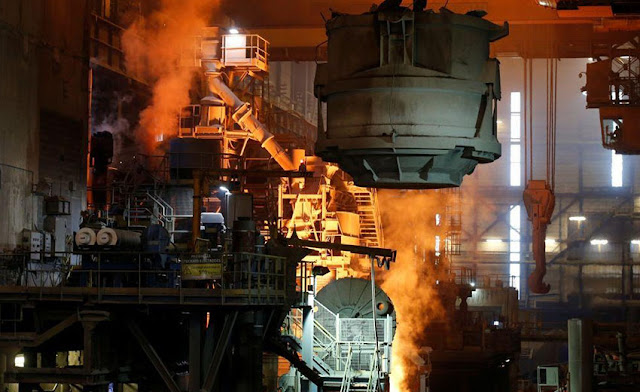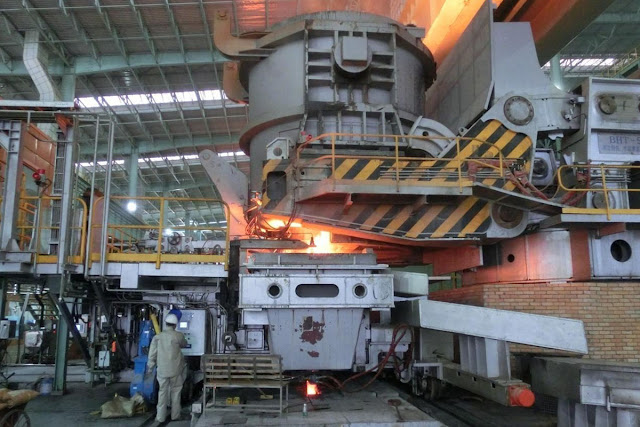Intermediate frequency furnace
Intermediate frequency furnace is a power supply device that converts 50HZ power frequency alternating current into intermediate frequency (above 300HZ to 20K HZ). It converts three-phase power frequency alternating current into direct current after rectification, and then converts the direct current into adjustable intermediate frequency current. The medium frequency alternating current flowing in the capacitor and the induction coil generates high-density magnetic lines of force in the induction coil, and cuts the metal material contained in the induction coil, which generates a large eddy current in the metal material.
This kind of eddy current also has some properties of intermediate frequency current, that is, the free electrons of the metal itself flow in the resistive metal body to generate heat. For example, if a metal cylinder is placed in an induction coil with alternating intermediate frequency current, the metal cylinder is not in direct contact with the induction coil, and the temperature of the electrified coil itself is already very low, but the surface of the cylinder is heated to redness or even melting , and this redness and melting speed can be achieved only by adjusting the frequency and the strength of the current. If the cylinder is placed in the center of the coil, then the temperature around the cylinder is the same, and the heating and melting of the cylinder will not produce harmful gas or bright light to pollute the environment.
Smelting furnace characteristics of intermediate frequency furnace series:
(1) High melting efficiency, good power saving effect, compact structure, strong overload capacity
(2) The temperature around the furnace is low, there is less smoke and dust, and the working environment is good.
(3) The operation process is simple and the melting operation is reliable.
(4) The metal composition is uniform.
(5) The melting temperature is fast, the furnace temperature is easy to control, and the production efficiency is high.
(6) The furnace utilization rate is high and it is convenient to change the varieties.
(7) The long arc-shaped yoke shields the magnetic flux leakage and reduces the external magnetic resistance. There is magnetic leakage at both ends of the shielded coil. The inner side of the yoke section is arc-shaped and seamlessly adheres to the outer wall, which increases the effective magnetic permeability area and makes the lower ring Get better support. The unique positive and negative coils greatly improve the efficiency of the system.
Intermediate frequency furnace series diathermic furnace features:
●Fast heating speed, high production efficiency, less oxidation decarbonization, saving materials and forging die costs
●Excellent working environment, improving workers' working environment and company image, no pollution, low energy consumption
●The heating is uniform, the temperature difference between the core and the surface is very small, and the temperature control accuracy is high
Intermediate frequency furnace heating device has the advantages of small size, light weight, high efficiency, excellent thermal processing quality. It is rapidly eliminating coal-fired furnaces, gas furnaces, oil-fired furnaces and ordinary resistance furnaces. It is a new generation of metal heating equipment.
The intermediate frequency furnace is the main equipment of the foundry, forging and heat treatment workshop. The stability, reliability and safety of its work are the guarantee for the normal and stable operation of the casting, forging and heat treatment production line of the flow operation.
Electric arc furnace
An electric furnace for smelting ores and metals using the high temperature generated by the electrode arc. The energy is concentrated when gas discharge forms an arc, and the temperature of the arc zone is above 3000 ℃. For smelting metals, electric arc furnaces are more flexible than other steelmaking furnaces, can effectively remove impurities such as sulfur and phosphorus, furnace temperature is easy to control, and the equipment occupies a small area, which is suitable for smelting high-quality alloy steel. Electric arc furnaces can be divided into three-phase electric arc furnaces, consumable electric arc furnaces, single-phase electric arc furnaces and resistance electric arc furnaces according to the arc form. The furnace body of the electric arc steelmaking furnace is composed of a furnace cover, a furnace door, a tapping trough and a furnace body, and the furnace bottom and furnace walls are built with alkaline refractory materials or acid refractory materials.
Electric arc steelmaking furnaces are divided into ordinary power electric arc furnaces, high power electric arc furnaces and ultra-high power electric arc furnaces according to the transformer capacity per ton of furnace capacity. Electric arc furnace steelmaking is to input electric energy into the electric arc steelmaking furnace through graphite electrodes, and the electric arc generated between the electrode end and the charge is used as the heat source for steelmaking. The electric arc furnace uses electric energy as the heat source, and the atmosphere in the furnace can be adjusted, which is extremely beneficial to the smelting of steels that contain more oxidizable elements. Soon after the invention of electric arc furnace steelmaking, it was used to smelt alloy steel and has been greatly developed.
With the improvement of electric arc furnace equipment and the improvement of smelting technology, the development of electric power industry, the cost of electric arc furnace steelmaking continues to decline. Now electric arc furnace steelmaking is not only used for the production of alloy steel, but also for the production of ordinary carbon steel. The proportion of output in the total steel output of major industrial countries continues to rise.
The cost of electric arc furnace is very expensive, but the product quality is good, the public frequency furnace consumes the most electricity, the intermediate frequency furnace is 800-900 degrees/ton below 2000KW, and the large furnace is 600-700 degrees/ton. These are just normal conditions, plus human factors ( operation proficiency, equipment maintenance level), equipment aging, various compensation, harmonic control, and other factors will affect power consumption.
Compared with electric arc furnace, the cost of intermediate frequency furnace steelmaking is lower, and it is suitable for small and medium-sized enterprises (small workshops). However, the steel produced by it has many impurities and high carbon content, so the steel produced is not pure, and those with low requirements can choose The steel produced by the intermediate frequency furnace is usually more than 3 tons in volume. Therefore, the electric arc furnace is only used by enterprises with a certain scale, and the steel produced by it is relatively pure.
The electric arc furnace uses power frequency electricity, while the intermediate frequency electric furnace uses intermediate frequency electricity.
More Articles You May Be Interested In:
Energy-Saving Technology for Heat Treatment of Induction Furnace
Furnace Transformer – Electric Arc Furnace
Classification of Electric Arc Furnace
Nine Ways to Save Electricity in Steel-making Electric Furnace
Melting Features of Medium Frequency Electric Furnace
Electric Arc Furnace VS Intermediate Frequency Furnace
Walking Beam Reheating Furnace VS Push-steel Reheating Furnace
Why Intermediate Frequency Furnace cannot be Turned on Normally?
Energy-Saving Technology for Heat Treatment of Induction Furnace
Cause Analysis and Solution of Induction Coil Blocking in Medium Frequency Smelting Furnace
Characteristics of Electric Arc Furnace Steelmaking
Electric Arc Furnace Continuous Charging Control Technology
What is Induction Furnace?
The Advantage of Induction Furnace (Medium Frequency Furnace)
On the Advantage and Disadvantage of Electric Arc Furnace and Induction Furnace
Electric arc furnace
An electric furnace for smelting ores and metals using the high temperature generated by the electrode arc. The energy is concentrated when gas discharge forms an arc, and the temperature of the arc zone is above 3000 ℃. For smelting metals, electric arc furnaces are more flexible than other steelmaking furnaces, can effectively remove impurities such as sulfur and phosphorus, furnace temperature is easy to control, and the equipment occupies a small area, which is suitable for smelting high-quality alloy steel. Electric arc furnaces can be divided into three-phase electric arc furnaces, consumable electric arc furnaces, single-phase electric arc furnaces and resistance electric arc furnaces according to the arc form. The furnace body of the electric arc steelmaking furnace is composed of a furnace cover, a furnace door, a tapping trough and a furnace body, and the furnace bottom and furnace walls are built with alkaline refractory materials or acid refractory materials.
Electric arc steelmaking furnaces are divided into ordinary power electric arc furnaces, high power electric arc furnaces and ultra-high power electric arc furnaces according to the transformer capacity per ton of furnace capacity. Electric arc furnace steelmaking is to input electric energy into the electric arc steelmaking furnace through graphite electrodes, and the electric arc generated between the electrode end and the charge is used as the heat source for steelmaking. The electric arc furnace uses electric energy as the heat source, and the atmosphere in the furnace can be adjusted, which is extremely beneficial to the smelting of steels that contain more oxidizable elements. Soon after the invention of electric arc furnace steelmaking, it was used to smelt alloy steel and has been greatly developed.
With the improvement of electric arc furnace equipment and the improvement of smelting technology, the development of electric power industry, the cost of electric arc furnace steelmaking continues to decline. Now electric arc furnace steelmaking is not only used for the production of alloy steel, but also for the production of ordinary carbon steel. The proportion of output in the total steel output of major industrial countries continues to rise.
The cost of electric arc furnace is very expensive, but the product quality is good, the public frequency furnace consumes the most electricity, the intermediate frequency furnace is 800-900 degrees/ton below 2000KW, and the large furnace is 600-700 degrees/ton. These are just normal conditions, plus human factors ( operation proficiency, equipment maintenance level), equipment aging, various compensation, harmonic control, and other factors will affect power consumption.
Compared with electric arc furnace, the cost of intermediate frequency furnace steelmaking is lower, and it is suitable for small and medium-sized enterprises (small workshops). However, the steel produced by it has many impurities and high carbon content, so the steel produced is not pure, and those with low requirements can choose The steel produced by the intermediate frequency furnace is usually more than 3 tons in volume. Therefore, the electric arc furnace is only used by enterprises with a certain scale, and the steel produced by it is relatively pure.
The electric arc furnace uses power frequency electricity, while the intermediate frequency electric furnace uses intermediate frequency electricity.
More Articles You May Be Interested In:
Energy-Saving Technology for Heat Treatment of Induction Furnace
Furnace Transformer – Electric Arc Furnace
Classification of Electric Arc Furnace
Nine Ways to Save Electricity in Steel-making Electric Furnace
Melting Features of Medium Frequency Electric Furnace
Electric Arc Furnace VS Intermediate Frequency Furnace
Walking Beam Reheating Furnace VS Push-steel Reheating Furnace
Why Intermediate Frequency Furnace cannot be Turned on Normally?
Energy-Saving Technology for Heat Treatment of Induction Furnace
Cause Analysis and Solution of Induction Coil Blocking in Medium Frequency Smelting Furnace
Characteristics of Electric Arc Furnace Steelmaking
Electric Arc Furnace Continuous Charging Control Technology
What is Induction Furnace?
The Advantage of Induction Furnace (Medium Frequency Furnace)
On the Advantage and Disadvantage of Electric Arc Furnace and Induction Furnace









